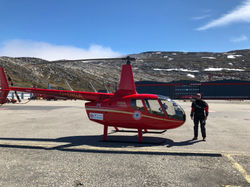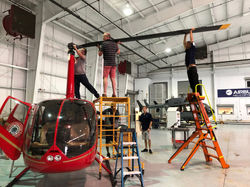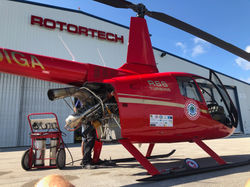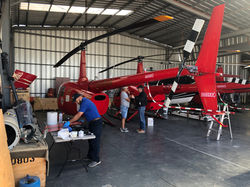
Three Journeys Round
 |  |  |  |  |
|---|---|---|---|---|
 |  |  |  |  |
 |  |  |  |  |
 |  |  |  |  |
 |  |  |
Details about the helicopter
I have access to a Robinson R66 helicopter, which uses readily available Jet A1 fuel and operates easily to 10,000 feet above sea level. I have flown Robinson helicopters since 1998. I type rated on the R66 in 2014 and train others to fly it. In 2015 I set about exploring the R66’s capability and limits. I do not have an instrument rating and I conduct all the flying under VFR (Visual Flying Rules).
The R66 is a great machine when flown loaded. I plan for an average of 100 knots ground speed. Then I fly about 62% Torque or up to 110 knots as the fuel burns off, and as long as it is smooth. The R66 doesn’t like turbulence and I experienced thermal turbulence in the hot, arid countries. Of course, the R66 can go faster, but I wanted to reduce the wear and tear and bring the helicopter home inexpensively!
For Africa I practised to get single pilot operation slick. After discussion with other pilots, I developed solutions to reduce problems in the cockpit. I mounted all my navigation and camera equipment around me for left-hand operation. I wore all my beacons. The helicopter I was using had the usual selection of analogue instruments and a Garmin 420. I added software on my iPad and a Garmin 795, which is more resilient to harsh, sunny conditions.
The critical bit of equipment was my Delorme tracker & texting beacon using the Iridium network. This I use for flight following, my first point of search and rescue should I need it, and en-route weather and communications with my handlers. I establish positive two-way communications before I lift for every flight.
I conduct all activities with the correct clearances, skills training, licences and safety equipment in place. My equipment includes a Spinlock lifejacket, Typhoon dry suit, Revere Aero Compact 2-man Lift raft, gloves & hood, Ocean Signal PLB1 and EPERB1, Electronic flares, waterproof case for my iPhone, a grab bag with survival essentials, and a basic tool and spares kit.
I operate all flights within a well-prepared Search And Rescue protocol through my 24/7-support with GASE.
In South Africa, I designed a simple, inexpensive sun visor for the trip north back across the Sahara.
As a result of my brownout experience flying between Tamanrasset, Algeria and Agadez, Niger in the Sahara Desert, I made two significant changes for the round the world flight: I recruited a co-pilot and installed a two-axis autopilot with sponsorship support from Genesys. This helped significantly to reduce my workload. So much so, that I am happy to return to single pilot operation for South America using the autopilot.
I also designed brackets to hold equipment to replace the suckers I used in Africa, which ping off at altitude at the most inopportune moment! I migrated to an Iridium I-GO with WIFI connection to my iPhone, which is Bluetooth connected to the Bose headsets. This meant I had Satphone connection for the ‘Operations Normal’ calls in Taiwan, Russia and Greenland. And finally, I had a small cover designed for the tail rotor pinch links, which helped greatly to reduce exposure to dusty conditions.